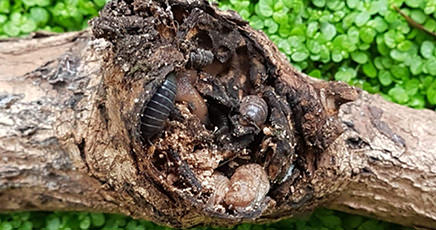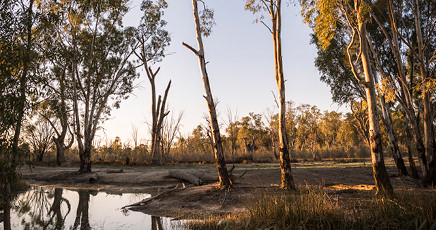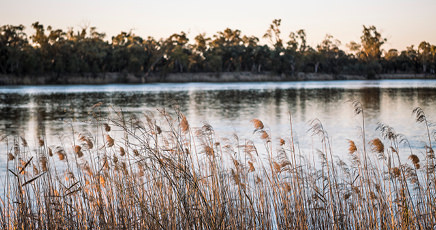STORY
With Tom by her side, Suyin decided to approach their teacher and ask if they could start a school project to protect the wildlife habitat in their school and local area. They believed that this would help the other children become aware of the local wildlife habitat, and help safeguard the homes of the native animals and plants who call it home. Suyin knew this project would help the children who lived across the valley find out more about the food and shelter requirements for the native animals and plants that had been impacted by the new housing estate.
The teacher thought their project idea was brilliant! The whole school would be involved and learn why it was important that both urban and rural environments can provide habitat for native wildlife to help them survive.

Urban and rural environments can provide habitats for native wildlife to ensure their ongoing survival. Creating a wildlife habitat is one way to safeguard your local native species and encourage new species to make the garden their home.
The research activity enabled our learners to discover what species live in their local area. In the vision activity, learners will discover what these species need to survive.
This learning activity is the second part of a sequence of 5 individual learning activities focused on creating a wildlife habitat. The order of these learning activities are: research, vision, design, planting and monitoring and care.
We encourage our Junior Landcarers to learn more about wildlife habitats by exploring these other learning activities. These include the Creating a frog-friendly habitat sequence: research, design and construction, Creating a bee hotel sequence: research and construction as well as Building a nest box.
For children to:
- create a vision of what their local ecosystems could be
- understand the connections between local species and their habitats
- create a community to help create wildlife habitats
- enjoy being active and productive outdoors and build their social and teamwork skills
- understand the steps involved in creating a wildlife habitat.
This activity can be undertaken any time of the year.
Introduction
Having an understanding of the needs of native animals in your school or local area will help build a connection to place, and help to get support from your community to a create a wildlife habitat. This activity enables children to appreciate the diversity of local native animals in the community and understand how to protect them.
*Time allocation will be dependent on site selection and travel time. Additional time may be spent in consultation with your local Landcare group, council, or native plant nursery.
Checklist
Instructions
STEP 1
Habitat requirements
What are your goals and your creative ideas in creating your habitat garden? What wildlife would you like to attract and support?
All animals need food, water and shelter to survive. A habitat provides a safe place to live, but not all animals need the same type of habitat. For example, Brushtail Possums live in tree hollows and like to feed on insects and flowers, whilst skinks like to bask in the sun and shelter in leaf litter.
Thinking about the animals you would like to attract to your wildlife garden, choose three of the animals you discovered during the research activity. Discuss their habitat requirements. Where does the animal like to live? What does it feed on? Record these details in the activity sheet.
Use the field guide book, online resources, or Wildlife App in the checklist to help your research.
STEP 2
Animal habitats
Now that you have found out more about the food and shelter requirements for your animals, what else might they need?
Your local environment may not always be able to provide some of the shelter needed for your animals. Using built features can also help to provide shelter, particularly when your new habitat is establishing.
Are there any built features the animals in your local area might need? These could include a lizard lounge, nest boxes, an insect hotel or water feature such as a frog pond.
Draw one of these built features in the Activity Sheet and be creative in your design.
STEP 3
How plants create habitat
Ideally, in an outdoor location surrounded by a range of native plant forms, discuss how plants create habitats for wildlife, focusing on the animals living needs.
To ensure biodiversity when creating your wildlife habitat, it is important to use a variety of native plant forms (such as trees, shrubs, flowers and grasses). This creates a multi layered environment providing lots of safe places for small birds and other animals.
There are lots of people in the community that can help you learn more about the plants that thrive in your local area. Contact your local Landcare group, Traditional Custorians, local council or native plant nursery to discuss plant choices and where to source them. They can often provide you with a local plant species list to use.
STEP 4
Choosing native plants
Use a local plant species list or plant guide to help make a list of plants for your new habitat.
Record plant suggestions in the table in the activity sheet along with their plant form (tree, shrub, grass). This will help you to think about the plants to be included in your design.
After completing the activity sheet, reflect on your learnings. Children can discuss their ideas and vision with each other. How are we going to use this knowledge to create a suitable habitat for local wildlife species? In the discussion consider:
- limitations and restrictions
- who might be able to help?
- what equipment might we need?
- what budget is required?
Extension Activity
Invite students to join a Junior Landcare group and participate in an upcoming Landcare or environmental event. You could also invite your local Landcare group out to your school.
Use the Conservation Management Zones of Australia to identify the management zone you live in. Download the PDF to discover any Vulnerable, Endangered or Critically Endangered species live near you. Write down their common name, species names and their conservation status in the table in the Activity Sheet. Discussion: Would your wildlife habitat help these species? How?
Curriculum and Framework Links
SCIENCE
Year 3: ACSHE050, ACSIS053, ACSIS054, ACSIS057, ACSIS215, ACSIS060
Year 4: ACSSU075, ACSSU073, ACSIS064, ACSIS216, ACSIS071
Year 5: ACSSU043, ACSHE083, ACSIS231, ACSIS086, ACSIS090
Year 6: ACSSU094, ACSSU096, ACSHE098, ACSHE100, ACSIS221, ACSIS110
Year 7: ACSSU112, ACSSU116, ACSHE223, ACSHE120, ACSHE121, ACSIS125, ACSIS133
Year 8: ACSHE135, ACSHE136, ACSIS139, ACSIS145, ACSIS148
GEOGRAPHY
Year 7: ACHGK037, ACHGK038, ACHGK039, ACHGK040, ACHGK042, ACHGS050
Year 8: ACHGK051, ACHGK052, ACHGK053
HUMANITIES, ARTS & SOCIAL SCIENCES
Year 3: ACHASSK072
Year 5: ACHASSK114, ACHASSK118
HEALTH AND PHYSICAL EDUCATION
Year 3 & 4: ACPPS035, ACPPS038
Year 5 & 6: ACPPS056
Year 7 & 8: ACPPS073
ETHICAL UNDERSTANDING
Exploring values, rights and responsibilities
PERSONAL AND SOCIAL CAPABILITY
Social awareness
CURRICULUM CONNECTIONS
Outdoor Learning
CROSS CURRICULUM PRIORITY
Sustainability
MY TIME, OUR PLACE: FRAMEWORK FOR SCHOOL AGE CARE
Outcome 2 and 4
Reference List
ONLINE RESOURCES
Use the information at Backyard Buddies to explore native animals and their habitats.
This Gardens for Wildlife article from Sustainable Gardening Australia provides a list of considerations when creating a wildlife garden.
Use the interactive map to discover Conservation Management Zones of Australia and learn more about the animals and plants in these areas.
To find a Landcare group in your local area try the Landcare group directory.
WATCH
Watch these Gardening Australia videos to learn more about creating wildlife habitats: Gardens for Wildlife (6 minutes), Creating lizard lounges (6 minutes), Birds in the Burbs (7 minutes).
IMAGE ATTRIBUTION
Feature image:
Galah courtesy of Richard Woodgett
Other image:
Photo of insects under bridge by Adam H. (2020 What’s in your backyard challenge Top 100)
We value your feedback
When you have finished this learning activity, please tell us what you think with our survey.
Your feedback will help Landcare Australia improve the activities in the Junior Landcare Learning Centre.
Why not try one of our other Junior Landcare learning activities?
Creating a butterfly garden
Biodiversity
Love Letters to the Land
Biodiversity|First Nations Perspectives|Food Production|Waste Management
Creating a sensory garden
Biodiversity
Understanding weeds: life cycle
Biodiversity


